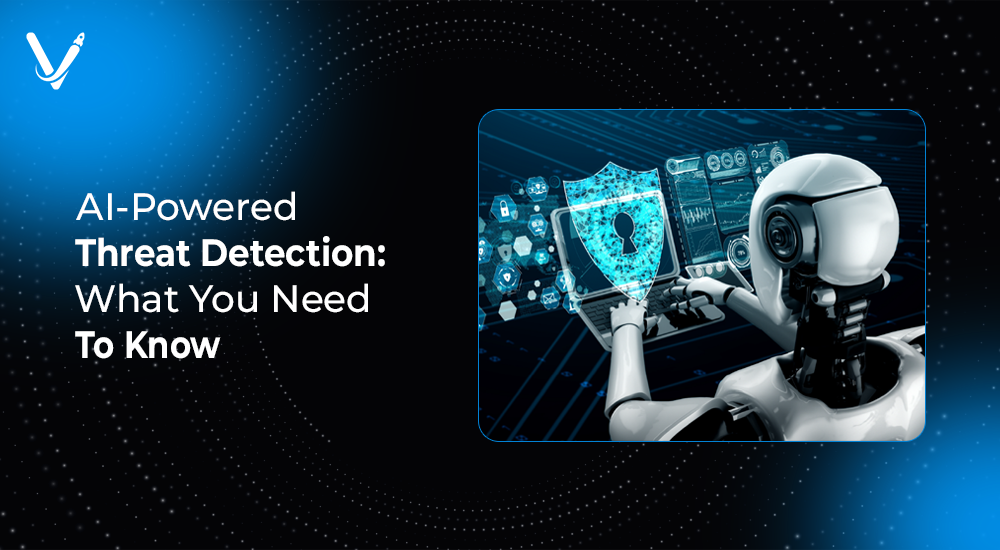AI-Powered Threat Detection: What You Need to Know


- Jun 4, 2025
In an era where data breaches can cripple entire industries and cyberattacks grow more sophisticated every day, traditional cybersecurity defenses are no longer enough. Organizations need smarter, faster, and more adaptive systems to identify and neutralize threats before they cause damage. That’s where AI-powered threat detection steps in.
Artificial Intelligence is transforming the way security teams approach threat monitoring and incident response. By mimicking human cognitive functions and learning from vast amounts of data, AI can detect anomalies, predict potential threats, and respond with unmatched speed and accuracy.
This blog dives deep into the world of AI-powered threat detection—how it works, why it matters, real-world applications, future trends, and how businesses can implement it effectively.
At its core, AI-powered threat detection refers to the use of artificial intelligence, including machine learning (ML) and deep learning, to monitor, identify, and respond to cyber threats in real time.
Instead of relying solely on signature-based methods (which detect threats based on known patterns), AI-based systems can:
Key technologies driving AI threat detection include:
Legacy security tools often rely on static rules and known threat signatures. These systems can’t keep up with the rapidly changing landscape of modern cyber threats such as:
AI overcomes these challenges by evolving alongside attackers. It doesn't need to be told what to look for; instead, it identifies unusual behavior, learns from it, and takes action automatically.
AI systems start by collecting raw data from various sources—network logs, endpoint activity, cloud infrastructure, IoT devices, emails, and more. This data is cleaned and standardized for analysis.
AI models extract features—relevant indicators or attributes—such as login frequency, IP address changes, file access patterns, or unusual file transfers.
Machine learning algorithms are then trained on this data to distinguish between normal behavior and malicious activity.
Once deployed, these models scan incoming data continuously to detect deviations. If something anomalous is spotted—say, an employee accessing financial data at 2 AM from a foreign IP—the system flags it for investigation or takes predefined action.
Some advanced platforms integrate with SOAR (Security Orchestration, Automation, and Response) tools to:
Banks and fintech companies use AI to analyze millions of transactions daily. When a customer’s spending pattern suddenly changes—like a $10,000 withdrawal in a foreign country—AI can flag the activity, halt the transaction, and trigger alerts.
Example: JPMorgan Chase deployed AI tools to analyze legal documents and detect fraud patterns, reducing 360,000 hours of work to mere seconds.
Hospitals store sensitive health records that are prime targets for ransomware. AI can monitor electronic health records (EHR) access logs and detect suspicious activity, such as mass downloads by unauthorized personnel.
Example: Boston Children’s Hospital implemented an AI-based system that identified anomalous access behavior and prevented a major data exfiltration attempt.
Online platforms face frequent credential stuffing attacks. AI detects login anomalies—such as location mismatches or bot-like typing patterns—and automatically initiates multi-factor authentication.
AI helps national security agencies sift through unstructured data, including social media chatter, to detect terrorism-related keywords or sentiment trends before a physical threat emerges.
AI reduces the mean time to detect (MTTD) and mean time to respond (MTTR) to threats, allowing businesses to mitigate breaches before damage occurs.
AI systems can analyze thousands of endpoints and millions of events per second—something impossible for human analysts alone.
Traditional systems often overwhelm security teams with alerts. AI significantly improves alert accuracy, enabling better prioritization and faster remediation.
AI doesn't just respond to threats—it anticipates them. It uncovers attack vectors before exploitation occurs, enabling proactive defense.
By automating repetitive tasks, AI reduces the workload on security teams and saves operational costs in the long run.
Despite its promise, AI in threat detection isn't without challenges.
AI is only as good as the data it learns from. Incomplete or biased datasets can lead to false conclusions.
Hackers are now using AI themselves. Some even attempt to fool detection models using adversarial inputs designed to look normal but are malicious.
Implementing AI into existing security infrastructures can be technically challenging, especially for small to mid-sized businesses.
There’s a growing gap in skilled AI and cybersecurity professionals, making effective deployment and tuning of AI systems harder for many organizations.
AI doesn’t eliminate the need for human expertise. Instead, it augments security analysts by:
Think of AI as a force multiplier—it doesn’t replace humans; it makes them more effective.
Before diving into AI tools, assess:
Some leading AI cybersecurity platforms include:
Evaluate platforms based on ease of integration, detection capabilities, and automation features.
Invest in upskilling your IT staff and cybersecurity analysts on how to use and interpret AI outputs effectively.
Run AI systems in shadow mode (observation only) initially to benchmark their accuracy and tune them before going live.
Threat landscapes evolve daily. Keep models updated, monitor performance, and adjust based on real-world feedback.
As AI matures, it will transition from reactive defense to predictive threat intelligence—forecasting threats before they materialize.
Fully autonomous platforms may soon manage cybersecurity with minimal human input, handling end-to-end threat detection, investigation, and remediation.
Technologies like honeypots and decoy systems can be powered by AI to mislead attackers and collect intelligence without exposing real assets.
As IoT and 5G networks expand, AI will play a crucial role in managing the enormous data flow and securing edge devices.
Cybersecurity is no longer a concern only for large enterprises. In fact:
AI-powered tools now come in cloud-native, affordable packages, making them accessible for startups and SMEs. Early adoption can be the difference between surviving a breach or suffering catastrophic losses.
Cyber threats aren’t slowing down—they’re accelerating in complexity and frequency. AI-powered threat detection is no longer optional; it’s an essential layer of modern cybersecurity.
By combining machine intelligence with human insight, businesses can build resilient defense systems capable of withstanding today’s dynamic threat landscape.
Vasundhara Infotech specializes in building secure, AI-driven digital solutions tailored for your business. Let us help you future-proof your cybersecurity strategy with cutting-edge threat detection systems.
Contact us today to explore how AI can safeguard your digital assets.
Copyright © 2025 Vasundhara Infotech. All Rights Reserved.
